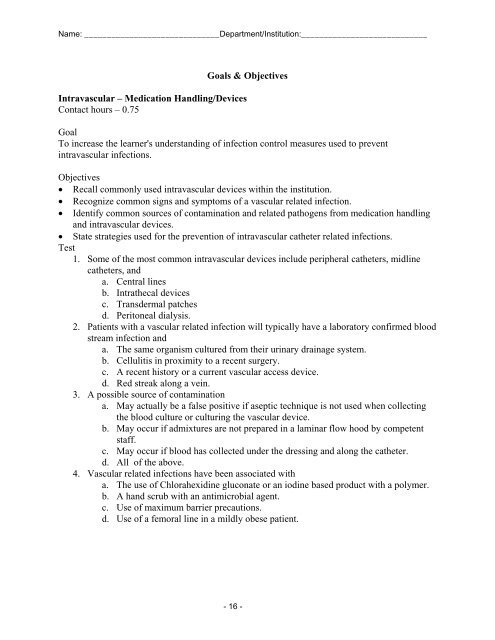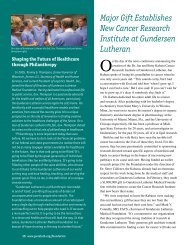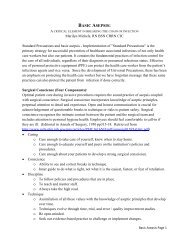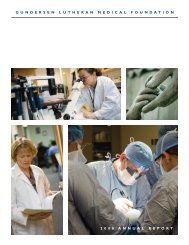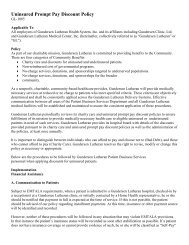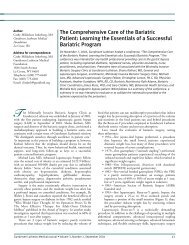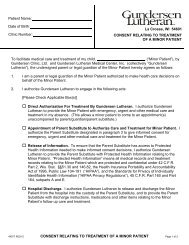Goals & Objectives Past and Present Issues of Infection Control ...
Goals & Objectives Past and Present Issues of Infection Control ...
Goals & Objectives Past and Present Issues of Infection Control ...
You also want an ePaper? Increase the reach of your titles
YUMPU automatically turns print PDFs into web optimized ePapers that Google loves.
Name: ______________________________Department/Institution:____________________________<br />
Intravascular – Medication H<strong>and</strong>ling/Devices<br />
Contact hours – 0.75<br />
<strong>Goals</strong> & <strong>Objectives</strong><br />
Goal<br />
To increase the learner's underst<strong>and</strong>ing <strong>of</strong> infection control measures used to prevent<br />
intravascular infections.<br />
<strong>Objectives</strong><br />
• Recall commonly used intravascular devices within the institution.<br />
• Recognize common signs <strong>and</strong> symptoms <strong>of</strong> a vascular related infection.<br />
• Identify common sources <strong>of</strong> contamination <strong>and</strong> related pathogens from medication h<strong>and</strong>ling<br />
<strong>and</strong> intravascular devices.<br />
• State strategies used for the prevention <strong>of</strong> intravascular catheter related infections.<br />
Test<br />
1. Some <strong>of</strong> the most common intravascular devices include peripheral catheters, midline<br />
catheters, <strong>and</strong><br />
a. Central lines<br />
b. Intrathecal devices<br />
c. Transdermal patches<br />
d. Peritoneal dialysis.<br />
2. Patients with a vascular related infection will typically have a laboratory confirmed blood<br />
stream infection <strong>and</strong><br />
a. The same organism cultured from their urinary drainage system.<br />
b. Cellulitis in proximity to a recent surgery.<br />
c. A recent history or a current vascular access device.<br />
d. Red streak along a vein.<br />
3. A possible source <strong>of</strong> contamination<br />
a. May actually be a false positive if aseptic technique is not used when collecting<br />
the blood culture or culturing the vascular device.<br />
b. May occur if admixtures are not prepared in a laminar flow hood by competent<br />
staff.<br />
c. May occur if blood has collected under the dressing <strong>and</strong> along the catheter.<br />
d. All <strong>of</strong> the above.<br />
4. Vascular related infections have been associated with<br />
a. The use <strong>of</strong> Chlorahexidine gluconate or an iodine based product with a polymer.<br />
b. A h<strong>and</strong> scrub with an antimicrobial agent.<br />
c. Use <strong>of</strong> maximum barrier precautions.<br />
d. Use <strong>of</strong> a femoral line in a mildly obese patient.<br />
- 16 -


